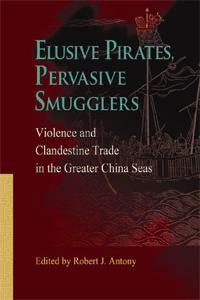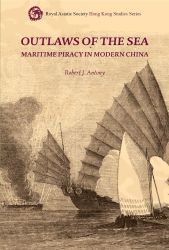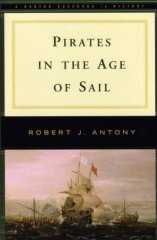 Pirates and Privateers Pirates and Privateers
The History of Maritime
Piracy
Cindy Vallar, Editor
& Reviewer
P.O. Box 425,
Keller, TX 76244-0425
    
Books for Adults ~ History: Piracy
Elusive Pirates, Pervasive Smugglers
Pirates in the
Age of Sail
Outlaws of
the Sea

Elusive Pirates, Pervasive
Smugglers: Violence and Clandestine Trade in the Greater
China Seas
edited by Robert J. Antony
Hong Kong University, 2010, ISBN 978-988-8028-11-5, US
$45.00 / HKD $295.00
    
These
scholarly essays examine the connections and history
of piracy and smuggling in Asian waters, both of
which have long been a way of life in this region.
These authors show how pirates and smugglers –
different, yet related – play key roles in how
society develops. The information unveiled clearly
shows the link between the past and the present,
especially in light of issues of maritime security
and national sovereignty.
Often given short shrift, these
two groups involve themselves in an illicit or
shadow economy, which coexists with legal trade.
Searching through documents in many different
languages and representing a variety of
perspectives, the historians share what their
research reveals about piracy and smuggling in the
greater China Seas region over a period of 600
years. They also discuss the integral and essential
roles both groups play in shaping the history of
China, Japan, and Southeast Asia.
The general arrangement of the ten chapters is
chronological, although the first one provides
somewhat of an overview.
“Violence at
Sea: Unpacking ‘Piracy’ in the Claims of States
over Asian Seas” is written by Anthony Reid,
professor emeritus of Australian National
University’s Department of Pacific and Asian
History. Concentrating on the Chinese and Malay,
he explores the differences between eastern and
western piracy, and how Europe’s colonial
expansion altered how people saw pirates.
Peter D.
Shapinsky, assistant professor of East Asian
history at the University of Illinois at
Springfield, examines perceptions of piracy in
“From Sea Bandits to Sea Lords: Nonstate Violence
and Pirate Identities in Fifteenth- and
Sixteenth-Century Japan.” By examining various
historical and cultural contexts, he shows how
these perceptions change from mercenaries and
pirates to legitimate, state-sponsored sea lords.
A research
fellow at the Centre of Asian Studies, University
of Hong Kong, James K. Chin specializes in the
history of maritime Asia. His use of contemporary
Chinese and Portuguese accounts in “Merchants,
Smugglers, and Pirates: Multinational Clandestine
Trade on the South China Coast, 1520-50” shows not
only the negative impact, but also the positive
influences on these groups had on the Chinese
economy.
“Pirates,
Gunpowder, and Christianity in Late
Sixteenth-Century Japan,” written by Maria Grazia
Petrucci, a doctoral student at the University of
British Columbia specializing in Japanese history,
analyzes how Europeans, merchants, and pirates
interacted to manufacture and smuggle gunpowder.
Igawa Kenji,
associate professor of the Graduate School of
Letters at Osaka University, discusses the impact
Chinese and Japanese pirates have on sea routes
that established the Philippine Islands as an
important player in international trade in “At the
Crossroads: Limahon and Wakō in Sixteenth-Century
Philippines.” The key points examined are: a) when
and why the Philippines become a crossroads; b)
who the pirates are and what their role is in this
development; and c) the relationship between
piracy and trade in this period, especially as
regards interactions between the Philippines and
Japan.
Paola Calanca
studies Ming and Qing navies and is an associate
professor of history at the École Française
d’Extrême-Orient. In “Piracy and Coastal Security
in Southeastern China, 1600-1780,” she explores
how government bans on maritime trade forced
people to become pirates and smugglers. She then
demonstrates how reversals in state policies
turned supporters of piracy into opponents.
Professor of
Chinese and comparative history at the University
of Macau and author of Pirates in the Age of
Sail, Robert J. Antony examines the rise of
piracy and the roles these bandits play in “Piracy
and the Shadow Economy in the South China Sea,
1780-1810.” He demonstrates how this illicit trade
impacts the economy from both a negative and
positive perspective.
Robert Hellyer’s
case study, “Poor but Not Pirates: The Tsushima
Domain and Foreign Relations in Early Modern
Japan,” scrutinizes how and why Tsushima, an
island and piracy haven in the 16th century,
changes through the intervention of agreements
with Korea. He also considers how and why the
people refrain from reverting to their piratical
ways when beset by economic hardship in the 17th
century. Hellyer is an assistant professor of
history at Wake Forest University, whose specialty
is early modern and modern Japanese history.
Ota Atsushi, assistant
research fellow at the Center of Asia-Pacific Area
Studies, Research Center for Humanities and Social
Sciences, Academia Sinica in Taipei, studies
Southeast Asia’s maritime history. His essay, “The
Business of Violence: Piracy around Riau, Lingga,
and Singapore, 1820-40,” focuses on how pirates
worked, their military and commercial networks,
and how the Europeans and locals dealt with
piracy.
“Smuggling in
the South China Sea: Alternate Histories of a
Nonstate Space in the Late Nineteenth and Late
Twentieth Centuries” concludes this collection.
Eric Tagliacozzo – an associate professor at
Cornell University who teaches Southeast Asian
history and Asian studies – examines smuggling in
two centuries to show how the past influences the
present.
This noteworthy study
contains an abundance of material that is enhanced
with illustrations, maps, chapter notes, and a
detailed bibliography and index. As Antony, who also
edits this volume, writes in his introduction, “this
is the first book to carefully examine piracy and
smuggling from [in-depth historical and comparative
perspectives] for the whole East and Southeast Asian
region.” Not only do these essays accomplish
this goal, but they skillfully show that eastern
piracy greatly differs from that of the west, and
that we need to study it from that perspective, more
so than that of the colonial powers who forced their
definition of piracy onto this region.
The other strength of Elusive Pirates, Pervasive
Smugglers is it explores the past, rather than
focusing on the present, as many recent books have.
In doing so, these scholars provide readers with a
better understanding of “the problems of piracy and
smuggling . . . [and] that they are deep-rooted,
complex, and evolving phenomena.”
Review
Copyright ©2010 Cindy Vallar


Outlaws of the Sea: Maritime
Piracy in Modern China
by Robert J. Antony
Hong Kong University, 2025, ISBN
979-988-8876-77-8, US $65.00 / HKD $350.00
Also available in other formats
    
Anyone
who reads my column knows there is a
difference between Eastern and Western piracy.
In fact, the concept of piracy is unknown
until after Europeans venture into Asian
waters. When I want to explore Chinese piracy,
one of my go-to historians is Robert J.
Antony, who has been researching piracy in the
South China Sea and along China’s southern
coast for forty years. Outlaws of the Sea
is his latest offering and gathers this
research into a single volume that covers the
1630s through the 1940s. Within the eleven
chapters of this book, readers will find a
balanced examination of pirates from multiple
perspectives taken from a wide gamut of
historical resources.
In “Introduction: The Pirate and the
Historian,” Antony discusses the difficulties
historians encounter when researching Chinese
history. He makes clear that the names
associated with specific pirates are not the
names the pirates themselves used. For
example, Zheng Yi Sao is mandarin, a language
the pirates don’t know. They speak a language
of South China, which makes her Cheng Yat Sou
or Shek Yeung. Equally compelling is how
Antony gives voice to these pirates, imagining
what they may say if asked.
“The Sociopolitical Culture of South China’s
Water World” explores the Qing dynasty and
those who make their living on the sea in
south China between 1740 and 1840. The chapter
shows this society’s mercurial nature and
provides a framework of understanding for the
chapters that follow. This information gives
credence to the governor of Fujian’s words in
1799: “People are not born pirates, but they
become pirates because the land cannot support
them.” (23) It is a time when three distinct
groups of pirates consist of 80,000 people.
Piracy impacts and shapes history, a state’s
legal regimes, and the state’s desire to build
empires. In “Piracy, Empire, and Sovereignty,”
Antony explains how piracy influences the
development of the Qing Empire during a
300-year period. He also shares how Chinese
officials view pirates and how those views
differ from Western ones. Equally important is
how officials’ attitudes toward and their
handling of piracy changes between the days of
Zheng Zhilong and his followers and the rise
of the pirate confederation led by Zheng Yi
and Zheng Yi Sao.
When three brothers stage a revolt in Vietnam
in the 1770s, they eventually form alliances
with Chinese pirates. This leads to a new
state, and “Chinese Pirates and Tay Son
Rebels” examines the dynamics of this
relationship.
During a span of thirty years, socioeconomic
conditions hold great sway in the development
and upsurge in piracy in the South China Sea.
Piratical attacks may be deemed illegal, but
the pirates consider themselves justified in
what they do. “Piracy and the Shadow Economy”
explores pirate lairs, black markets, and
ports friendly to pirates, as well as the
detrimental and beneficial aspects of piracy
as a business and the clandestine networks
through which they operate.
The resurgency of piracy between 1780 and
1810, greatly impacts Canton trade. “Defending
Canton: Chinese Pirates, British Traders, and
Hong Merchants” looks at the effect this has
on the relations between China and Britain,
the repercussions on trade, and how merchants
based in Hong Kong help defend the city
against the pirates.
In “Pacification of the Seas,” the time comes
when pirates can no longer be tolerated by the
state, and Qing officials use a variety of
techniques to suppress piracy. Although many
disapprove the offering of “carrots,” Antony
shows how pardons often prove more successful
than “sticks.”
While the state sometimes uses violence to
counteract piracy, the pirates also implement
brutality and terror for economic and
political reasons. In “Bloodthirsty Pirates?”
Antony asks a number of related questions to
delve into “the physical, emotional, and
magico-religious aspects of pirate violence.”
(139)
“Pirates, Dragon Ladies, and Steamships”
focuses on piracy between 1840 and 1940, when
steamships lead to hijackings becoming more
the norm for pirates. Antony compares and
contrasts piratical stereotypes in Western
media and its depiction of Chinese piracy,
even though it is never as simply defined or
shown as Westerners are led to believe.
In 1910, pirates kidnap and hold hostage
children and adults on an island while they
wait for the ransom to be paid. Finding this
intolerable, the Portuguese send military
expeditions against the pirates. In the
ensuing fight, innocent civilians lose their
lives. In “‘We Are Not Pirates’: Portugal,
China, and the Pirates of Coloane,” Antony
explores this incident and the
interrelationship between the Portuguese and
Chinese over four centuries. This incident
also demonstrates why it is so difficult to
define who is a pirate and what constitutes
piracy. Perspective plays a key role in what
transpires here.
Piracy is not stagnant. As time passes, it
changes and shifts depending on who and what
are involved. One region’s pirate may not be
the same as another’s. The similarities and
differences between Western and Eastern piracy
are examined in “Conclusion: Piracy in China
and the World.”
Each chapter stands on its own, but in reading
the book cover to cover, readers gain a better
understanding of 300 years of piracy and its
role in shaping the history of both China and
the world. The narrative incorporates numerous
figures, maps, and tables, while a chronology,
glossary, bibliography, and index complete the
book. Footnotes are found throughout,
providing citations and additional
information.
This is an engaging, compelling, and
informative examination of Chinese piracy. It
is difficult for any reader to come away
without learning something new. As Antony
states in his introduction: “This book is
about recovering the silences and seeking the
truths about piracy . . . My focus is on
piracy as historical, political, social, and
cultural phenomena . . . My main aim is to
explore the world of Chinese pirates and to
explicate the integral role they played in
shaping China’s maritime society in the modern
age.” (9) He achieves all of this and more. I
highly recommend Outlaws of the Sea to
anyone who wishes to gain a better
understanding of piracy in Asian waters and
why western ideas of piracy fail to fully
capture who these people are, what they do,
and how they fit into and influence Chinese
society as a whole. This volume deserves
inclusion within any library interested in
this region, and for any reader interested in
comprehending the differences between Eastern
and Western pirates.
Review
Copyright ©2025 Cindy
Vallar


Pirates in the Age of Sail
by Robert J. Antony
W. W. Norton & Company, 2007, ISBN
978-0-393-92788-7, US $15.00
    
Most books on
maritime piracy focus on one
region, particularly the
Caribbean. This Norton Casebook in
History examines piracy worldwide
from 1500 to 1850. Major events
and persons are examined in
respect to the political, social,
economic, cultural, and sexual
changes occurring during this time
period. Maps, pictures, and tables
illustrate the material within the
book, which is divided into three
sections.
Part
one presents an overview of
piracy. The subsections cover:
Pirates, Privateers, and
Buccaneers of the West;
Corsairs, Renegades, and Slaves
of the Mediterranean; Pirates,
Merchants, and Rebels on the
China Coast; Raiders, Warriors,
and Traders in Southeast Asia;
and Global Piracy Today. Using
these same divisions, with the
exception of modern piracy, part
two presents primary documents
(or their translations)
pertaining to each region. A
sampling of these includes:
Deposition of
Adam Baldridge, Taken May 5,
1699
John Dann’s
Testimony against Henry Every
Captain William
Snelgrave’s Captivity, 1719
European Renegade
and Corsair John Ward
John Foss’
Captivity in Algiers, 1793-96
The Pirate Zheng
Zhilong
Depositions in
the Case of He Xing’s Gang,
1782
Narrative of
Richard Glasspoole’s
Captivity, 1809
An Oral History
of Sea Dayak Raiding
Handbill of
William Edwards, 1845
The final section
of the book contains three
essays. Jo Stanley writes on
women pirates; Marcus Rediker
discusses “Hydrarchy and
Libertalia”; and Joseph N. F. M.
à Campo examines piracy in
colonial Indonesia from 1816 to
1825. The bibliographic essay,
which appears before the index,
recommends noteworthy journal
articles and books where readers
can obtain additional
information.
This book contains one of the
most readable, concise, and
thorough overviews of piracy
during the Age of Sail
throughout the world that I’ve
encountered. While many volumes
provide quotes from primary
resources and eyewitness
accounts, this one provides
readers with a wealth of
examples, some of which are
rarely found elsewhere. These
documents also introduce readers
to lesser-known pirates and
piracy outside of the Caribbean.
One particularly valuable chart
lists the pirates in each region
with the time periods in which
they prey, allowing readers to
compare who does what at the
same time someone else pirates
in another region of the world.
Pirates in the Age of Sail
is an indispensable addition to
all pirate libraries. At $15
it’s a steal!
Review
Copyright ©2007 Cindy Vallar

Click to contact me
Background image compliments
of Anke's Graphics |



